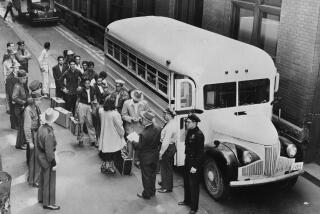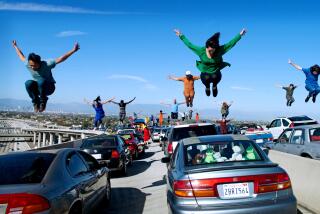Freeway Arch to Honor L.A. Immigrants
The vision is still hazy. And, considering the exhaust fumes, perhaps it always will be. Even so, Mayor Tom Bradley and an array of civic leaders trumpeted ambitious plans Friday for a monument celebrating Los Angeles as home to immigrants.
It would be located, of all places, above the Hollywood Freeway.
Los Angeles’ answer to the Statue of Liberty is heralded as the “West Coast Gateway”--a grand bridge, spanning the downtown freeway in airspace stretching from Alameda Street to Broadway.
In a hoopla-filled ceremony at El Pueblo de Los Angeles State Historic Park, sponsors of the 5 1/2-acre Gateway project announced that the winning architect in an international competition will design the $40-million project, to be funded entirely with private money, sponsors said. The target date for completion is Oct. 12, 1992, to coincide with the 500th anniversary of Columbus’ voyage to the New World.
“That hunk of air is going to be turned into a bridge!” actor George Takei, a promoter of project, declared as he pointed toward the freeway. “As so many of my New York friends say, it’s so L.A.!”
Gateway would be more than a symbol, its sponsors stressed, providing a physical, “spiritual, emotional and cultural connection” between Chinatown, El Pueblo de Los Angeles Park at Olvera Street, Little Tokyo and the Civic Center. Sponsors envision it as part of grand scheme to promote pedestrian use throughout downtown.
RTD board member Nick Patsaouras, chairman of the 20-member West Coast Gateway Committee, dismissed suggestions that freeway airspace is a poor place for a monument. About 30 feet above the noise and carbon monoxide of the freeway, Patsaouras told reporters, will be “a place of serenity.” Strategic use of fountains, he explained, would mask the noise.
Festive Occasion
At Friday’s event, Takei, best known as Sulu in the original “Star Trek” television series, shared the dais with a wide range of figures, ranging from Mayor Bradley to science fiction author Ray Bradbury. Entertainment included mariachis, Cajun folk singers, Appalachian clog dancers, a children’s choir, an African native dance troupe from Cal State Northridge and an aerobics team. The stage was wreathed in balloons colored white, black, brown, yellow and red--symbolizing the city’s ethnic diversity, said emcee Mario Machado.
The Gateway project is “an exciting concept that will pay tribute to the contributions of immigrants who have helped shape Los Angeles,” Bradley said.
Bradbury, a non-driver, noted that Angelenos will fly 9,000 miles to stroll the streets of Paris, but will drive their cars to travel two blocks in Los Angeles. Rhapsodizing at some length, Bradbury bemoaned the barriers separating the city’s historic Chinese, Latino and Japanese communities.
‘Our Immigrant Past’
“These proofs of our immigrant past stand but a few hundred yards or a few blocks apart. Yet they might as well be separated by tens of miles for all the mixing between these towns within a city,” Bradbury said.
“Rarely do the inhabitants of the three or four communities stroll from one to the other. Rarely do tourists, abandoning their cars, ricochet happily from one immigrant duchy to the next.
“All this must change.”
James Wood, chairman of the Community Redevelopment Agency, was less poetic. Part of the reason the Gateway should be built, Wood said, is that “there is no uglier part of Los Angeles now than that strip of the freeway.”
Plans for a Los Angeles version of the Statue of Liberty have been mulled over often in recent years. In March, 1987, Bradley appointed the committee headed by Patsaouras to devise such a “welcoming symbol” to new immigrants.
Airport, Harbor Ruled Out
Patsaouras said sites at Los Angeles International Airport and the harbor were considered and ruled out. As a member of the RTD board, Patsaouras said, he is familiar with the Union Station area, which will be the starting point for Metro Rail and hub of a planned 150-mile light-rail system.
He then proposed the Gateway bridge spanning the Hollywood Freeway, and the committee secured air rights from the California Department of Transportation.
So far, the committee has collected only $100,000--a contribution from the Japanese-owned Shuwa Corp.--to finance a design competition that Patsaouras hopes will attract more than 700 entries. More ambitious fund raising would begin later, with a special effort aimed at corporate contributions “in the same vein as the (1984) Olympics,” Patsaouras said.
Patsaouras, himself a Greek immigrant, became visibly emotional when he addressed the crowd as the final speaker.
“Together we will build a monument that will be a testament to the human spirit--a celebration of liberty and justice,” he said.
More to Read
Sign up for Essential California
The most important California stories and recommendations in your inbox every morning.
You may occasionally receive promotional content from the Los Angeles Times.










